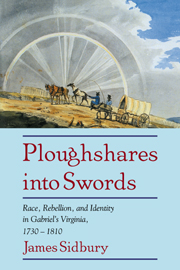Book contents
- Frontmatter
- Contents
- Acknowledgments
- Introduction
- Prologue: From Blacks in Virginia to Black Virginians
- 1 The emergence of racial consciousness in eighteenth-century Virginia
- Part I Cultural process: Creolization, appropriation, and collective identity in Gabriel's Virginia
- Part II Social practice: Urbanization, commercialization, and identity in the daily life of Gabriel's Richmond
- Epilogue: Gabriel and Richmond in historical and fictional time
- Appendix: Richmond households in 1784 and 1810
- Index
Introduction
Published online by Cambridge University Press: 04 August 2010
- Frontmatter
- Contents
- Acknowledgments
- Introduction
- Prologue: From Blacks in Virginia to Black Virginians
- 1 The emergence of racial consciousness in eighteenth-century Virginia
- Part I Cultural process: Creolization, appropriation, and collective identity in Gabriel's Virginia
- Part II Social practice: Urbanization, commercialization, and identity in the daily life of Gabriel's Richmond
- Epilogue: Gabriel and Richmond in historical and fictional time
- Appendix: Richmond households in 1784 and 1810
- Index
Summary
This book is not about Gabriel's Conspiracy. It is, instead, about the Black and White worlds of late-eighteenth-century Virginia, the worlds in which that conspiracy grew. People of recognized African descent who lived in Gabriel's Virginia, even those who were not enslaved, suffered enormous legal and social disadvantages associated with chattel slavery. This book illustrates many of those hardships, but it is not about them either. It focuses, instead, upon the ways that Blacks living in eighteenth-century Virginia made sense of their world, of their relationships to their own pasts, and of their relationships to the revolutionary tradition that White Virginians held so dear but also held to be irrelevant to “their” slaves. It uses Gabriel's Conspiracy and the evidence produced in the trials of alleged conspirators to open a window on the perceptions of people of African descent in Richmond at the turn of the nineteenth century. Blacks in Gabriel's Virginia forged a collective identity and a vibrant living culture of resistance through creative acts of appropriation that reconstituted Virginian culture. They turned their new creation, their new Virginian culture, into a weapon in their battle for the end of slavery and the genesis of racial justice.
These processes occurred at specific times and in specific places. Much of the best social history written during the last three decades has examined individual localities or communities and has tried to reconstruct the social and cultural forces that influenced people's day-to-day lives.
- Type
- Chapter
- Information
- Ploughshares into SwordsRace, Rebellion, and Identity in Gabriel's Virginia, 1730–1810, pp. 1 - 10Publisher: Cambridge University PressPrint publication year: 1997

